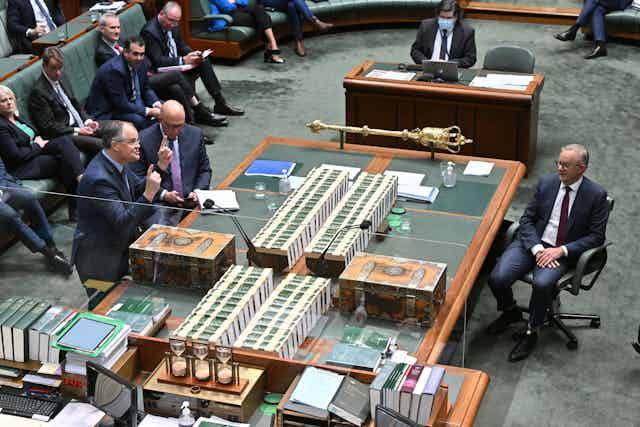Crazy brave, or just crazy? If, as seems likely, the opposition embraces nuclear power in its 2025 election policy, it will be taking a huge political gamble.
The Coalition might argue this would be the best (or only) way to ensure we achieve net zero by 2050. But “nuclear” is a trigger word in the political debate, and the reactions it triggers are mostly negative.
Opposition Leader Peter Dutton has been open since the election about nuclear energy being on the Coalition’s agenda. It’s a “no surprises” tactic – but one that has allowed the government, especially Climate Change Minister Chris Bowen, to regularly attack and ridicule the idea.
This week opposition climate change and energy spokesman Ted O'Brien was spruiking nuclear power, writing in The Australian about the US state of Wyoming’s plans for a coal-to-nuclear transition.
O'Brien visited some months ago. “What struck me was the extent to which residents were embracing their nuclear future,” he wrote. “Four coal communities had gone head-to-head in a competitive bid to host the state’s first nuclear plant.”
O'Brien, a Queensland Liberal, has been a vociferous nuclear advocate; he chaired a parliamentary inquiry under the former government that recommended work to deepen understanding of nuclear technology and a partial lifting of the present moratorium, dating from 1998, on nuclear energy.
Nationals leader David Littleproud has also been central to the push for the Coalition to back nuclear energy.
The Nationals, by their climate scepticism and their deep attachment to coal, held back the Coalition on climate policy for more than a decade. Ahead of the 2022 election they were dragged by Scott Morrison to agree to the 2050 target with a massive financial bribe (some of which they didn’t receive because of the change of government).
Now, in opposition, some of the Nationals’ rump would like the party to ditch the 2050 commitment. The nuclear option would be one means of keeping them in the tent.
The “nuclear” the Coalition is talking about doesn’t involve old-style plants, but “new and emerging technologies” including small modular reactors.
That’s one of the problems for the policy – this is an emerging technology, not a quick fix to Australia’s challenges in transiting from fossil fuels.
That is, however, nothing compared with the challenge of public opinion. Notably, the 2019 parliamentary report was titled Nuclear Energy - Not without your approval.
A 2022 Lowy poll found Australians divided on the issue of nuclear power, although opinion appeared to be softening. Some 52% supported removing the ban, which was a five-point rise from 2021; 45% opposed this – six points down on the year before.
The government would have a ready-made “not in my backyard” campaign to launch against the Coalition’s policy. Whether the Wyoming experience suggests feeling could be different in coal communities – which might see future jobs on offer – is, however, an interesting question.
Another extremely hard issue is that of waste. We only have to think of the massive difficulty in finding a disposal site for the waste from the Lucas Heights facility, which is from nuclear medicine.
The point was highlighted on Thursday when the Albanese government abandoned its plan for a waste dump near Kimba in South Australia. This followed an adverse federal court judgement, which upheld a challenge by local Indigenous people.
The government has decided not to appeal, presumably influenced by the delicate stage of the Voice referendum.
Resources Minister Madeleine King said: “The judgement was clear, and the government is listening”. She had visited Kimba in January and saw “a town divided” on the issue. The search will continue for another site.

The opposition called the failure to appeal “gutless”. Shadow foreign minister Simon Birmingham said a “strong majority” of the Kimba community had expressed a willingness to host the dump.
The failure to deliver this site creates huge uncertainties for nuclear medicines, leaves waste at temporary city sites all over Australia and undermines confidence that Labor is capable of the difficult decisions required to deliver nuclear powered submarines under AUKUS.
The opposition argues the planned nuclear submarine program provides a foot in the door to advance its case for nuclear energy. It will require limited onshore nuclear capability, and eventually Australia will have to deal with the waste from its boats.
But more persuasive, one would think – if people can be persuaded – would be high power prices and the difficulties of the energy transition, which we are already seeing as baseload power goes out of the system.
For that argument to work, however, the economics of nuclear power would have to stack up, and at present they don’t (although O'Brien disputes that).
Tony Wood, Director of the Energy Program at the Grattan Institute, lists some of the arguments against nuclear that the Coalition will have to deal with.
“There are doubts whether a small modular reactor could provide dispatchable power similar to a gas peaking plant,” Wood says.
There is also little real-world evidence these reactors would deliver cheaper prices, he says. “The SMRs are still in the early stages of development and already costing more than the proponents had expected.”
Nuclear in Australia is many years away, given the status of the technology and the fact we would have to train an entirely new workforce from scratch.
Lift the ban by all means. Nothing would change today. But the evidence that a social licence could be gained is minimal.
The Coalition might believe it is ahead of the curve on the potential for small nuclear reactors for Australia. Whether or not that’s so, only technology and history will tell.
But even if it is right, sometimes you can be too far ahead of the political curve. Bill Shorten’s climate policy in 2019 was only a very little ahead, but it turned into one of the obstacles for his campaign when he couldn’t convincingly answer all the questions about it.

